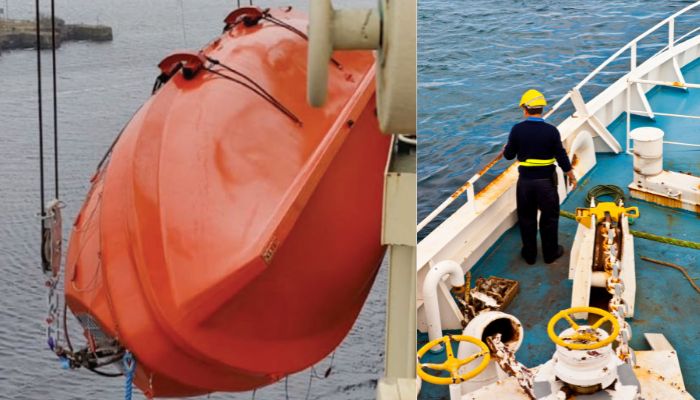

A vessel’s lifeboat with crew on board was being lowered to the water when the remote control lowering wire suddenly parted. Poor winch wire spooling under the outer layers led to a wire kink, creating a weak spot that contributed to the wire failure. The consequences in this instance were not serious, as the broken wire simply meant the brake was re-applied. However, had this been a real abandon ship, the consequences could have been more serious.
The remote control wire was replaced with an extra wire found on board, and another test was carried out the next day. The lifeboat crew boarded and the coxswain used the remote control wire to lift the brake and begin the descent. Again, the control wire failed to spool smoothly, and an unexpected pay-out of the control wire led to the winch brake prematurely engaging. The lifeboat stopped lowering and swung erratically above the embarkation deck.
Seconds later, the swinging motion caused the wire to regain tension. This lifted the winch brake arm and caused the lifeboat to lower again, still swinging. As the lifeboat swung, the skeg keel caught on the deck edge, and the lifeboat listed by more than 90°, as seen in the photo. A crewmember on deck quickly activated the winch brake lever to save the situation. Had the lifeboat inverted further the consequences could have been catastrophic.


An internal company investigation identified that the crew did not follow existing company policy, which required a test lowering without crew prior to embarking crew. The company’s policy is based on the recommendations contained within MSC.1-Circ.1578, Guidelines on Safety During Abandon Ship Drills Using Lifeboats. While a ‘test owering’ may not have prevented these incidents, it would have provided an opportunity to identify the poor spooling of the wire and prompted corrective action without risk to crew.
owering’ may not have prevented these incidents, it would have provided an opportunity to identify the poor spooling of the wire and prompted corrective action without risk to crew.
Lessons learned
Ship’s crew should conduct a thorough visual inspection of lifeboat launching systems and perform a test lowering before carrying out operations with crew on board. Pay special attention to the following inspection points:
Reference: The Nautical Institute










We believe that knowledge is power, and we’re committed to empowering our readers with the information and resources they need to succeed in the merchant navy industry.
Whether you’re looking for advice on career planning, news and analysis, or just want to connect with other aspiring merchant navy applicants, The Marine Learners is the place to be.